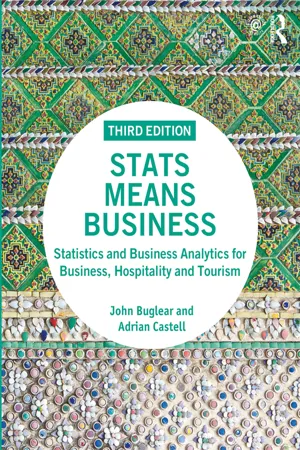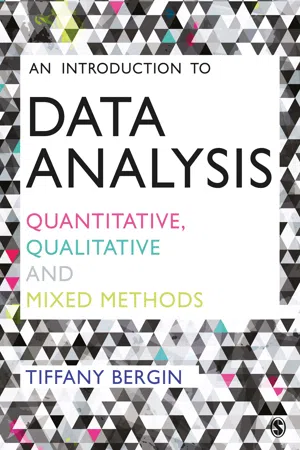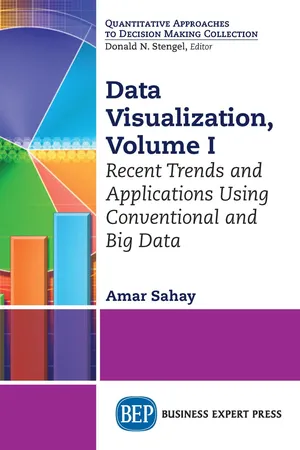Psychology
Graphs for Qualitative Data
Graphs for qualitative data in psychology are visual representations of non-numeric information, such as categories or characteristics. Common types of graphs for qualitative data include bar graphs, pie charts, and histograms. These graphs help to illustrate patterns, relationships, and distributions within qualitative data, making it easier for researchers and readers to interpret and understand the information.
Written by Perlego with AI-assistance
Related key terms
Related key terms
1 of 4
Related key terms
1 of 3
11 Key excerpts on "Graphs for Qualitative Data"
- eBook - ePub
Social and Behavioral Statistics
A User-Friendly Approach
- Steven P. Schacht(Author)
- 2018(Publication Date)
- Routledge(Publisher)
3Frequency Distributions, Graphs, and Charts
As noted in Chapter 1 , one of the foremost uses of statistics in the social and behavioral sciences is to describe phenomena in terms of variables and the relationships between them. One simple and highly effective way to do this is visually using graphs and charts—summary illustrations of quantitative and qualitative variables. Such pictorial displays are not simply aesthetically pleasant ways to summarize sets of numbers, they also enable us to visualize things about variables that we might miss by looking at just the numbers. Graphs and charts allow us to view variables and variable relationships in a manner that is often more meaningful and easier to understand. Perhaps this explains their widespread use in magazines, textbooks, and on television.This chapter explores graphs and charts in terms of how they are constructed and what they represent. Both graphs and charts ultimately represent and are constructed using what are called frequency distributions: predetermined organizational categories that group and summarize observations of a given variable(s). Quantitative versus qualitative variables, however, call for different types of histograms, frequency polygons, bar charts, and pie charts. As such, we first discuss quantitative and qualitative frequency distributions in terms of what they represent and how they are constructed. These four types of graphic representations then are discussed individually.Quantitative Frequency Distributions
At the most basic level, frequency distributions take raw data, also referred to as ungrouped data, and group (place) them into predetermined categories. Moreover, for any data set to be grouped in a meaningful manner, it must utilize what are called mutually exclusive and exhaustive - eBook - ePub
Stats Means Business
Statistics and Business Analytics for Business, Hospitality and Tourism
- John Buglear(Author)
- 2019(Publication Date)
- Routledge(Publisher)
A diagram is usually a much more effective way of communicating data because it is easier for the eye to digest than a table. This will be important when you have to include data in a report or presentation, because you want your audience to focus their attention on what you are saying. They can do that more easily if they don’t have to work too hard to understand the form in which you have presented your data.There are three types of diagram that you can use to show qualitative data: pictographs, pie charts and bar charts. They are listed here in order of increasing sophistication.2.3.1 Pictographs
A pictograph is no more than a simple adjustment of a summary table. The categories of the attribute are listed as they are in a summary table, but we use symbols to represent the number of things in each category. The symbols used are thematically linked to the nature of the data.Example 2.5
The table below shows the number of flights to different categories of destination departing from an airport in a six-hour period. Number of Departures by Type of DestinationShow this set of data in the form of a pictograph.Type of DestinationDeparturesDomestic 2 Short-haul 3 Long-haul 1 Figure 2.1 Pictograph of the number of departures by type of destinationA pictograph like Figure 2.1 can be an effective way of presenting a simple set of qualitative data. The symbols are a straightforward way of representing the number of things in each category and have the extra advantage of emphasising the context of the data.Unfortunately pictographs have several drawbacks that are likely to deter you from using them. Unless you are artistically gifted and can create appropriate images by hand, you will probably have to rely on computer software to produce them for you. Creating a pictograph by computer can be a laborious process. Spreadsheet and statistical packages cannot produce a pictograph for you directly from data, so symbols have to be grafted alongside text in a word-processing package.You need to choose the symbol you use carefully. It should be easy to associate with the context of the data and not so elaborate that the symbols themselves become the centre of attention rather than the data they are supposed to represent. - No longer available |Learn more
- Hugh Coolican(Author)
- 2018(Publication Date)
- Routledge(Publisher)
Chapter 14 Graphical representation of data This chapter deals with the representation of data sets in charts or graphs.- In a bar chart frequencies of data in discrete categories are presented for comparison and this must be done fairly, without visual distortion.
- Line charts are useful for demonstrating a time series – changes over time in a measure of a person or group.
- Interval data points, grouped into continuous categories, can be represented graphically as a histogram or as a frequency polygon.
- Tukey (1977) promoted techniques of exploratory data analysis with an emphasis on thorough examination of patterns before submitting data sets to tests of statistical significance. Two methods are included here: stem and leaf diagrams, and box-plots.
- SPSS procedures are included for common types of chart.
Graphs in general
People who dislike statistics nevertheless tend to like drawing graphs. However they are also prone to putting far too many of them into a report to make it look more interesting. It’s worth stopping to think, just what is a graph or chart for? It is not to make your report look more scientific or credible. Basically it transmits useful information to your reader. It should be a way of summing up at a glance the main features of your data or some important aspect of them. If it doesn’t do that, if it isn’t easy to understand completely (without referring to the text in your report) or if it presents the absolutely obvious, then it isn’t a good or useful chart. Before you rush to produce what many students find to be the most artistic part of a psychological research report, do take note of some cautionary advice.- Over-production and decoration – don’t scatter charts around your report showing every conceivable arrangement of data and in a profusion of pretty colours and patterns. You should be very parsimonious and only
- eBook - ePub
- John Buglear(Author)
- 2007(Publication Date)
- Routledge(Publisher)
Chapter 4 covered the arrangement of qualitative data in the form of summary tables. As well as being a useful way of displaying qualitative data, a summary table is an essential preliminary task to preparing a diagram to portray the data.A diagram is usually a much more effective way of communicating data because it is easier for the eye to digest than a table. This will be important when you have to include data in a report or presentation because you want your audience to focus their attention on what you are saying. They can do that more easily if they don’t have to work too hard to understand the form in which you have presented your data.Displaying qualitative data is fairly simple if there are few categories of the attribute or characteristic being investigated. With more categories, the task can be simplified by merging categories.There are three types of diagram that you can use to show qualitative data: pictographs, pie charts and bar charts. We will deal with them in this section in order of increasing sophistication.5.1.1 PictographsA pictograph is little more than a simple extension of a summary table. The categories of the attribute are listed as they are in a summary table, and we use symbols to represent the number of things in each category. The symbols you use in a pictograph should have a simple and direct visual association with the data.A pictograph like Figure 5.1 can be an effective way of presenting a simple set of qualitative data. The symbols are a simple way of representing the number in each category and have the extra advantage of emphasizing the context of the data.Figure 5.1Pictograph of the number of winners by each trainerExample 5.1 The table below lists four racehorse trainers and the number of horses they trained that won races at a horse race meeting.Show this set of data in the form of a pictograph.Trainer Number of winners Nadia Amazonka 5 Freddie Conn 3 Lavinia Loshart 1 Victor Sedlow 2 Pictographs do have some drawbacks that may put you off using them. Unless you are artistically gifted and can create appropriate images by hand, you will probably have to rely on computer software to produce them for you. Creating a pictograph using a PC can be a laborious process. Spreadsheet and statistical packages cannot produce a pictograph for you directly from data, so symbols have to be grafted alongside text in a word processing package. - eBook - ePub
The Journey to Dissertation Success
For Construction, Property, and Architecture Students
- Elizabeth Laycock, Tim Howarth, Paul Watson(Authors)
- 2016(Publication Date)
- Routledge(Publisher)
Qualitative data analysis supports the development of rich meaning and description. In order to promote meaning and enable richness in description, great care needs be taken to ensure quotes and descriptions taken from the qualitative raw data are presented with full reference to emerged themes and categories. Failure to do so can result in the dissertation presenting a list of disparate information rather than a coherent narrative.Tabulation of data enables the presentation of data in a structured way. Through the considered use of tables, qualitative data can be clearly arranged, themed and stratified. Flow charts are also commonly utilised to illustrate, map and communicate processes, as illustrated in Figure 8.1 .Flow chart illustrating aspects of the dissertation research processFigure8.1Techniques for presenting qualitative data
Whilst tables and flow charts are commonly used to organise and arrange the presentation of qualitative data, there is a variety of visualisations that can provide a useful way of summarising this often complex information. They can assist the reader to easily view evidence and information which supports the analysis. A good visualisation can reduce the need for excessive descriptive text. Even relatively simple visualisation techniques such as use of shading or colour (Figure 8.2 ) can help to improve the clarity of information presented within the thesis.Final ranking of importance of candidates' skills and attributes during employee selectionFigure8.2There may be occasions when quantitative data presentation techniques assist in providing richness to the understanding of a qualitative phenomenological, ethnographic or grounded theory investigation. Quantitative-based visuals such as Venn diagrams and Wordles may also serve to assist in the presentation of meaning.Venn diagrams can be used to illustrate and communicate the relationships between groups or sets of data. Such diagrams can prove to be a very useful tool in presenting relationships between themes, attitudes, opinions and perceptions. Figure 8.3 - eBook - ePub
An Introduction to Data Analysis
Quantitative, Qualitative and Mixed Methods
- Tiffany Bergin(Author)
- 2018(Publication Date)
- SAGE Publications Ltd(Publisher)
When deciding which visualization method to use, you should consider the specific characteristics of your data. For example, if you have quantitative data, is that data continuous or categorical ? (If you can’t remember the difference between these two terms, take a look back at Chapter 5.) As we will learn, some visualization methods work best with data that exhibits specific characteristics. Additionally, you should also consider the particular aims of your research. What are your goals? What information do you hope to communicate through visual methods? Finally, you need to think about visual appeal. Does your visualization capture the attention of viewers? Here’s your chance to sharpen your artistic skills, and bring some creativity to your scientific work. With these concerns in mind, we’ll now look in depth at different visualization options. Let’s start with the most basic method for visualizing data – a table. 9.6.1 Tables Tables are a common tool for presenting data, findings, or other information in an straightforward and organized fashion. If you’ve ever conducted quantitative research, you’re probably very familiar with tables; many statistical software packages automatically generate tables as they produce results. These automatically generated tables are usually edited and reformatted before being included in a paper, thesis, or journal article. You can also create your own tables in the word-processing program of your choice. Table 9.3 illustrates how quantitative data can be effectively communicated in tabular format. Table 9.3 s y Do you recognize Table 9.3 ? We’ve seen it before! It’s actually a copy of Table 5.3 from the discussion of correlation in Chapter 5. The table displays the calculations necessary for computing the standard deviation of a variable - eBook - ePub
- Amar Sahay(Author)
- 2016(Publication Date)
- Business Expert Press(Publisher)
CHAPTER 3 Visual Representation of Data Most widely used Charts and Graphs IntroductionOne of the major functions of data analysis is to describe the data in a way that is easy to comprehend and communicate. This can be done both by presenting the data in graphical form and by calculating various summary statistics such as the measures of central tendency and the measures of variability. The graphical techniques enable the analyst to describe a data set that is more concise than the original data. These techniques help reveal the essential characteristics of the data so that effective decisions can be made.In this chapter, we have presented numerous graphical techniques. You may be familiar with many of them; therefore, we will not discuss the theory behind them in detail. Instead, we will explain how to construct these graphs and charts using the computer and explain their important characteristics.Collection and Presentation of Data The following two methods are commonly used for describing data:• Tables• GraphsThe purpose of collecting data is to draw conclusions or to make decisions. To draw meaningful conclusion, the data are organized, grouped, plotted, and analyzed. Organizing data into groups is known as frequency distribution . The data should represent all relevant groups. Suppose a market survey is conducted to forecast the demand for a product in a particular area and 200 consumers are surveyed. It is important that this group contains a variety of consumers representing variables such as income level, education, gender, race, etc.Data can be collected through actual measurements or observations or can be obtained from government or company records. This information can be organized in a way that can be used to make decisions or draw conclusions. When data are arranged in a compact, usable form, decision makers can obtain reliable information and use it to make decisions. - eBook - ePub
Interaction Design
Beyond Human-Computer Interaction
- Helen Sharp, Jennifer Preece, Yvonne Rogers(Authors)
- 2019(Publication Date)
- Wiley(Publisher)
- Decide how best to enter it into spreadsheet software, for example, how to handle answers to close-ended questions. Then enter the data and generate some graphical representations. As the data set is likely to be small, think carefully about what, if any, graphical representations will provide meaningful summaries of the findings.
- Is there any data for which simple measures, such as percentages or averages, will be helpful? If so, calculate the three different types of average.
- Consider your qualitative data.
- Based on your refinement of the study question “improving the product,” identify some themes in the qualitative data, for example, what features of the product cause people difficulties? Did any of the participants suggest alternative designs or solutions? Refine your themes and collate extracts of data that support the theme.
- Identify any critical incidents in the data. These may arise from interviews, questionnaire responses, or observation. Describe these incidents carefully and choose one or two to analyze in more depth, focusing on the context in which they occurred.
- Collate your findings as a presentation and deliver them to a group of peers.
- Review the presentation and any questions from the audience. Consider how to improve the analysis and presentation.
Summary
This chapter described in detail the difference between qualitative and quantitative data and between qualitative and quantitative analysis.Quantitative and qualitative data can be analyzed for patterns and trends using simple techniques and graphical representations. Qualitative data may be analyzed inductively or deductively using a variety of approaches. Thematic analysis (an example of inductive analysis) and data categorization (an example of deductive analysis) are common approaches. Analytical frameworks include conversation analysis, discourse analysis, content analysis, interaction analysis, grounded theory, and systems-based approaches. - eBook - ePub
Single Case Research Methodology
Applications in Special Education and Behavioral Sciences
- Jennifer R. Ledford, David L. Gast, Jennifer R. Ledford, David L. Gast(Authors)
- 2018(Publication Date)
- Routledge(Publisher)
7Visual Representation of DataAmy D. Spriggs, Justin D. Lane, and David L. GastImportant Terms
graphic display, abscissa, ordinate, origin, tic marks, axis labels, condition, phase, condition labels, figure caption, line graph, bar graph, cumulative graph, semi-logarithmic chart, scale break, blocking- Graphic Displays of Data
- Types of Graphic Displays
- Line Graphs
- Bar Graphs
- Cumulative Graphs
- Semi-logarithmic Charts
- Guidelines for Selecting and Constructing Graphic Displays
- Figure Selection
- Graph Construction
- Data Presentation
- Using Computer Software to Construct Graphs
- Tables
- Summary
Graphs should represent complex information without distortion, and should serve a clear purpose (Tufte, 2001). They should “induce the reader to think about the substance rather than about methodology, graphic design, the technology of graphic production, or something else” (Tufte, 2001, p. 1). Maximizing the impact of your data while minimizing consumer focus on “something else” can be done by following guidelines for graphing data that come from professional organizations (e.g., American Psychological Association [APA]), historical precedent, and empirical knowledge (i.e., research). In single case design (SCD) research, graphic displays are not only a way to share your outcomes with consumers of your research (as is also common in between-groups studies), but also to enable you to make formative decisions throughout the process of the study. Thus, well-designed graphics are essential in good SCD research.Graphic displays - eBook - ePub
Social Research Methods
The Essentials
- Nicholas Walliman(Author)
- 2015(Publication Date)
- SAGE Publications Ltd(Publisher)
Thirteen Presenting Data GraphicallyA picture is worth a thousand words, so goes the saying, and there is an element of truth in this, but only if the picture is a true reflection of the data. The best way to present data is in graphical form, which can provide a compact list of the results, describe the data according to some criteria of measurement or bring them into relationship with other data. In the previous chapters on data collection and analysis, various ways of presenting data have been mentioned in the text. This chapter illustrates examples of a wide selection of these graphics, and provides some advice on their features and how to use them appropriately.In general, in order to present data effectively in graphics, you have to do several things at once to make sure that it:- Accurately illustrates the data
- Presents the data as simply as possible
- Uses colour to clarify the message
- Is consistent across comparative presentations.
Graphics should be used to stimulate thinking by enabling the interpretation of data. You can use them effectively to reduce the amount of textual explanation when describing trends, relationships and comparisons. It is, of course, important to use the right type of graphic to portray your ideas. As a rule you should ensure that each graphic has a heading and that the components are labelled and the data sources are indicated.With all graphics, you should devise a title or caption that provides enough detail that the reader can understand the content without needing to consult the accompanying text. Number them too – tables are usually numbered separately from other graphics and pictures – entitled ‘figures’. In longer texts such as dissertations, you will need to provide a list of tables and figures with their page numbers at the beginning with the contents list. You can use the ‘insert caption’ facility in your word-processor to make this simple. - eBook - ePub
- Patrick White(Author)
- 2023(Publication Date)
- Policy Press(Publisher)
While tables are fine for showing simple relationships, graphs are usually better when the relationship is complicated. As Few (2012, p 49) notes, graphs have a ‘unique power to reveal patterns of various types, including changes, differences, similarities, and exceptions’. It’s much easier to see a trend over time on a line graph, for example, that it is when looking at the figures in a table. And as we’ll see later in this chapter, a bar chart can immediately convey differences between many different categories. If your story is primarily about a relationship you have discovered, or differences between a large number of groups, a graph or chart might show this relationship or these differences much more effectively than a table.How many different units of measurement do I need to show?Graphs generally work best with only one or two different measures and can become difficult to read with multiple measures. Tables, on the other hand, can include lots of different measures because, unlike graphs, they’re not limited by having only two (or maybe three) axes. It’s quite common, for example, for a reader to want to see exact frequencies and exact percentages, which can be easier to present clearly in a table. When the exact values of three or more different measures need to be shown, a table tends to be a better option.How large is the dataset I am presenting?While it’s possible to show very large datasets in tables, when you have more than a relatively small number of data points to display, it will usually be easier to see patterns and relationships in the same data displayed as graph or chart. In general, large tables aren’t an effective method of telling a story. If you have a dataset that covers a large number of years, for example, any changes over time will be much easier to follow on a line graph. Few (2012, p 48) notes that ‘the patterns revealed by graphs enable readers to detect many points of interest in a single collection of information’ in a way that would be very difficult in a table. He uses the example of a scatterplot
Index pages curate the most relevant extracts from our library of academic textbooks. They’ve been created using an in-house natural language model (NLM), each adding context and meaning to key research topics.
Explore more topic indexes
Explore more topic indexes
1 of 6
Explore more topic indexes
1 of 4










